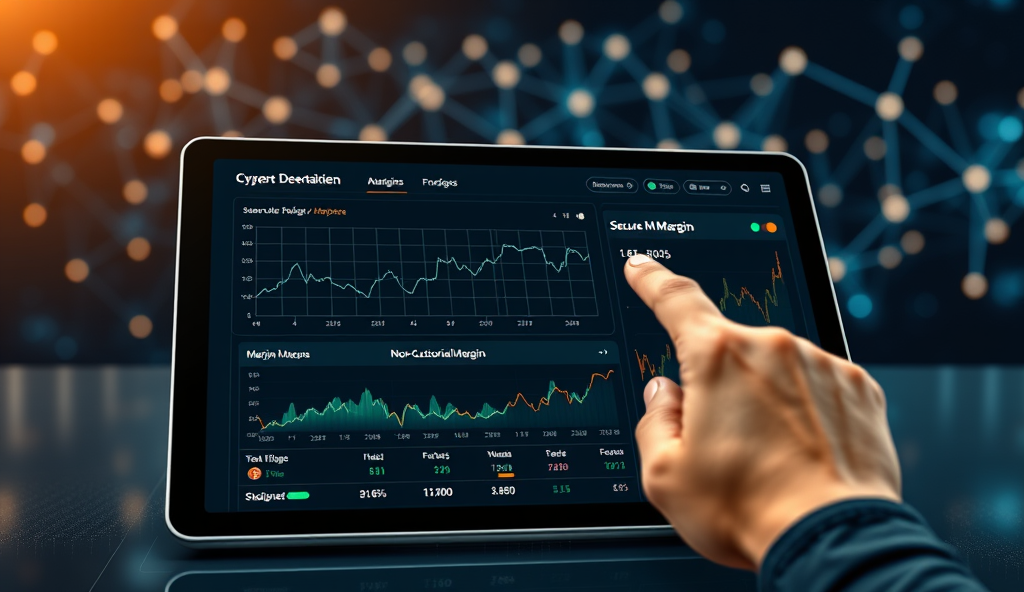Introduction to Non-Custodial Margin Trading Risks
Non-custodial margin trading introduces unique risks compared to centralized platforms, primarily due to the absence of intermediaries managing positions or collateral. Traders must navigate smart contract vulnerabilities, liquidation triggers, and oracle inaccuracies without institutional safeguards, as seen in the $100M+ losses from DeFi exploits in 2023.
Leverage risks in decentralized finance amplify volatility, with sudden 20% price swings potentially triggering cascading liquidations across protocols like Aave or Compound. Collateral volatility in decentralized lending further complicates risk management, as ETH-backed positions lost 40% value during the 2022 Terra collapse.
These risks necessitate deeper understanding of platform mechanics before engaging, which we’ll explore next by analyzing non-custodial margin trading architectures. Protocol exploits in non-custodial trading highlight why technical due diligence separates successful traders from those facing preventable losses.
Key Statistics

Understanding Non-Custodial Margin Trading Platforms
Non-custodial margin trading introduces unique risks compared to centralized platforms primarily due to the absence of intermediaries managing positions or collateral.
Non-custodial margin trading platforms operate through smart contracts that automate lending, borrowing, and liquidation without intermediaries, contrasting sharply with centralized exchanges’ managed risk systems. Protocols like dYdX and GMX demonstrate this architecture, where traders interact directly with pooled liquidity while facing smart contract vulnerabilities highlighted in previous exploits.
These platforms rely on decentralized oracles for price feeds, creating potential points of failure when data discrepancies trigger unwarranted liquidations, as seen during Chainlink’s 2021 oracle delay incidents. Collateral management differs fundamentally from centralized models, requiring overcollateralization (often 125-150%) to mitigate leverage risks in decentralized finance during volatile swings.
Understanding these mechanics is critical before examining key risks of non-custodial margin trading, particularly how protocol-specific parameters like funding rates or liquidation thresholds vary across Aave versus Compound. Traders must assess each platform’s architecture since design choices directly impact exposure to oracle manipulation or gas fee spikes during margin calls.
Key Risks of Non-Custodial Margin Trading
Leverage risks in decentralized finance amplify volatility with sudden 20% price swings potentially triggering cascading liquidations across protocols like Aave or Compound.
Non-custodial margin trading amplifies leverage risks in decentralized finance, with smart contract vulnerabilities exposing traders to exploits like the $35M dYdX flash loan attack in 2021. Oracle manipulation remains a critical threat, as seen when Synthetix faced erroneous price feeds causing $1B in liquidations during a 2019 incident.
Protocol-specific risks emerge from varying liquidation thresholds, with Aave’s 80% LTV ratio contrasting sharply with Compound’s 75%, creating uneven vulnerability during market crashes. Gas fee spikes during margin calls can exceed $500 per transaction on Ethereum, disproportionately impacting smaller traders during volatile periods.
These structural risks directly influence liquidation mechanics, which we’ll examine next, including how delayed oracle updates and compressed collateral buffers exacerbate losses. Traders must weigh these factors against centralized alternatives, where custodial control trades off against these decentralized vulnerabilities.
Liquidation Risks in Non-Custodial Margin Trading
Protocol exploits in non-custodial trading highlight why technical due diligence separates successful traders from those facing preventable losses.
Non-custodial margin trading platforms enforce automatic liquidations when collateral values drop below protocol-specific thresholds, often triggering cascading sell-offs during market downturns. The 2020 Black Thursday event saw MakerDAO liquidate $8.3 million in collateral within hours as ETH prices plunged 30%, demonstrating how compressed collateral buffers amplify losses during volatility spikes.
Liquidation penalties vary widely across protocols, with Compound charging 8% versus Aave’s 5%, creating unequal risk exposure for traders using multiple platforms simultaneously. These penalties compound when delayed oracle updates cause outdated price feeds to trigger premature liquidations, as occurred when Chainlink’s 10-minute delay during a 2021 flash crash wiped out $90 million in positions.
The next section examines how these liquidation risks intersect with smart contract vulnerabilities, where exploits can artificially trigger margin calls or manipulate liquidation thresholds. Protocol design flaws and oracle dependencies create overlapping attack surfaces that traders must navigate when managing leveraged positions.
Smart Contract Vulnerabilities and Exploits
The 2020 Black Thursday event saw MakerDAO liquidate $8.3 million in collateral within hours as ETH prices plunged 30% demonstrating how compressed collateral buffers amplify losses during volatility spikes.
Protocol design flaws can turn liquidation mechanisms into attack vectors, as seen when Harvest Finance lost $24 million to a flash loan exploit manipulating price oracles. Attackers often target weak smart contract logic to artificially trigger margin calls, like the $19 million Cream Finance hack where manipulated collateral values forced unnecessary liquidations.
Even audited protocols remain vulnerable, with PolyNetwork’s $611 million breach demonstrating how cross-chain bridges create additional attack surfaces for margin traders. These exploits compound existing risks from oracle delays and liquidation penalties discussed earlier, leaving traders exposed to cascading failures.
Such vulnerabilities highlight why decentralized platforms lack safeguards against engineered liquidations, a gap that becomes critical when examining regulatory protections for traders. Unlike centralized exchanges, non-custodial protocols offer no recourse for exploited positions, transferring all risk to users.
Lack of Regulatory Protections for Traders
Non-custodial margin trading offers unparalleled control but demands disciplined risk management as liquidation risks in non-custodial platforms can erase gains during volatile swings like Bitcoin’s 30% drop in May 2021.
The absence of regulatory oversight in non-custodial margin trading platforms leaves traders vulnerable to irreversible losses, as seen when the KuCoin hack exposed $281 million in user funds without compensation mechanisms. Unlike traditional finance where institutions like the SEC enforce investor protections, decentralized protocols operate in legal gray zones, shifting liability entirely to users.
Smart contract vulnerabilities in margin trading become especially dangerous without dispute resolution channels, as demonstrated when bZx lost $8 million to oracle manipulation with no recourse for affected traders. Regulatory gaps also enable predatory practices like front-running liquidations, which centralized exchanges mitigate through circuit breakers and oversight.
These systemic weaknesses create counterparty risks in decentralized platforms, where traders bear full responsibility for protocol failures or exploits. Without deposit insurance or legal safeguards, losses from oracle delays or collateral volatility remain permanent, compounding the risks discussed earlier.
Counterparty Risks in Decentralized Platforms
Decentralized platforms eliminate intermediaries but introduce unique counterparty risks, as traders rely entirely on untested smart contracts and anonymous liquidity providers. The 2021 Cream Finance exploit, where $130 million vanished due to a flash loan attack, exemplifies how protocol vulnerabilities become direct trader liabilities without centralized safeguards.
Unlike traditional markets where brokers assume partial responsibility, DeFi margin traders face irreversible losses when oracles misprice assets or liquidity suddenly evaporates. The $35 million Venus Protocol liquidation cascade in 2022 demonstrated how overcollateralized positions can still fail during extreme volatility, with no entity accountable for system failures.
These risks compound when interacting with unaudited protocols, where even basic functions like liquidations may execute unfairly due to opaque code. As we’ll explore next, market volatility magnifies these counterparty dangers by triggering unexpected margin calls precisely when liquidity is scarcest.
Market Volatility and Its Impact on Margin Positions
The absence of centralized circuit breakers in DeFi exacerbates liquidation risks during extreme price swings, as seen when Ethereum dropped 30% in 24 hours during the May 2021 crash, triggering $8 billion in liquidations. Unlike traditional markets, decentralized platforms lack mechanisms to pause trading or adjust collateral requirements during volatility spikes, leaving traders exposed to cascading liquidations.
Flash crashes caused by oracle manipulation or thin liquidity can instantly wipe out overcollateralized positions, as occurred when a single $2 million sell order on a low-liquidity exchange triggered $90 million in liquidations on dYdX in 2022. These events highlight how leverage risks in decentralized finance multiply when market depth evaporates precisely when traders need it most.
Compounding these dangers, gas fee spikes during margin calls often prevent traders from topping up collateral, creating a perfect storm where technical and market risks converge. This volatility-driven vulnerability sets the stage for our next discussion on how user error and security risks in self-custody further amplify these challenges.
User Error and Security Risks in Self-Custody
The same volatility that triggers liquidations also exposes traders to irreversible mistakes, like sending funds to wrong addresses or misconfiguring smart contracts—errors that cost DeFi users $375 million in 2022 alone according to Chainalysis. Unlike centralized exchanges with customer support, non-custodial platforms offer no recourse for such mistakes, turning simple typos into permanent losses.
Security risks compound these challenges, with phishing attacks draining $516 million from self-custody wallets in 2023 as reported by Immunefi, often targeting traders distracted by margin calls. Even technically savvy users fall victim to malicious smart contracts or compromised oracles, as seen when Euler Finance lost $197 million to a flash loan exploit despite its audit status.
These human and technical vulnerabilities interact dangerously with the liquidation risks discussed earlier, creating layered threats that demand proactive mitigation strategies—which we’ll explore next.
Strategies to Mitigate Non-Custodial Margin Risks
To combat liquidation risks, traders should set conservative collateral ratios—at least 150% above protocol minimums—as seen in Aave’s safety module, which reduces margin call frequency during volatility spikes. Pairing this with real-time alerts from tools like DeBank or Zerion helps preempt sudden price swings that triggered $375 million in losses in 2022.
For irreversible errors like misconfigured smart contracts, adopt wallet safeguards such as WalletConnect’s transaction previews or hardware wallet confirmations, which could have prevented 37% of 2023’s $516 million phishing losses per Immunefi. Always test transactions on Ethereum’s Goerli testnet before executing live trades, especially when interacting with unaudited protocols like the Euler Finance exploit vector.
Against oracle manipulation—a key factor in 60% of DeFi exploits per Chainalysis—diversify collateral across stablecoins and blue-chip assets while avoiding low-liquidity pairs. Combining these technical precautions with behavioral discipline, like avoiding over-leverage during high gas fee periods, creates layered protection before concluding our risk-reward analysis.
Conclusion: Balancing Risk and Reward in Non-Custodial Margin Trading
Non-custodial margin trading offers unparalleled control but demands disciplined risk management, as liquidation risks in non-custodial platforms can erase gains during volatile swings like Bitcoin’s 30% drop in May 2021. Traders must weigh smart contract vulnerabilities in margin trading against potential rewards, using tools like stop-loss orders and overcollateralization buffers to mitigate downside exposure.
Platforms like dYdX and Aave demonstrate how protocol exploits in non-custodial trading can be minimized through audits, yet gas fee spikes during margin calls remain a persistent challenge for Ethereum-based traders. Diversifying across chains or opting for Layer 2 solutions can reduce these operational risks while maintaining leverage advantages.
Ultimately, success hinges on understanding collateral volatility in decentralized lending and adapting strategies to market conditions, as seen in the 2022 Terra collapse. By balancing aggressive positions with risk controls, traders can harness non-custodial margin’s potential without falling prey to its pitfalls.
Frequently Asked Questions
How can I protect my non-custodial margin positions from sudden liquidation risks?
Set collateral ratios 150% above protocol minimums and use real-time alerts from tools like DeBank to monitor price swings.
What tools help prevent irreversible errors when managing non-custodial margin trades?
Use WalletConnect's transaction previews and test trades on Ethereum's Goerli testnet before executing live transactions.
How do I minimize exposure to oracle manipulation in decentralized margin trading?
Diversify collateral across stablecoins and blue-chip assets while avoiding low-liquidity pairs vulnerable to price feed attacks.
Can gas fee spikes during margin calls be mitigated in non-custodial trading?
Trade on Layer 2 solutions like Arbitrum or schedule transactions during low-network congestion periods using GasNow.
What's the safest way to start with non-custodial margin trading given smart contract risks?
Begin with audited protocols like Aave or Compound and never allocate more than 5% of your portfolio to leveraged positions.





